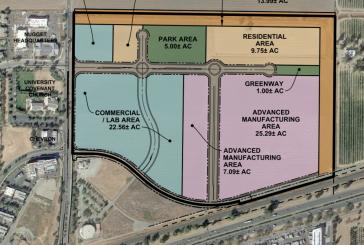
Commentary: Claims in Measure H Ballot Argument Largely Supported by Documentation
By David M. GreenwaldExecutive Editor
Davis, CA – While there will be plenty of opposition to Measure H (DiSC 2022), most of the claims are at least supported by the documentation.However, like most campaign statements, there is a little fudging.
First, they write that this will “build affordable housing for the next generation of Davis residents and families.” On the one hand, it is true that the project contains 85 affordable housing units of which 74 will be built on site.One could further argue that the 460 total units of workforce housing meet the definition of small “a” affordable housing.However, the primary purpose (though there is no such requirement) of these units is to provide housing for people working at DiSC so as to reduce vehicle trips and this implies a broader usage than that.
Next, “protect endangered species and permanently preserve hundreds of acres of agricultural land.”By city ordinance, the project is required to provide 2 to 1 ag mitigation.“Developer shall preserve agricultural land at minimum ration of 2:1. At full build-out, Developer shall have purchased agricultural conservation easements in a manner compliant with City Ordinance and subject to City approval. Compliance with agricultural mitigation may be achieved in phases as the project develops over time and portions are developed.”
To protect burrowing owls, “The agricultural buffer shall include one burrowing owl den complex.”Further, “The burrowing owl complex will be managed and monitored for owl use in consultation with a third-party wildlife biologist.”Thus the project does include protection for the burrowing owl, but whether the voters will consider that to be sufficient is a subjective question for individual voters.
The remainder of the claims are derived directly from four sources: (1) The Project Baseline Features, (2) the Development Agreement, (3) the EPS Fiscal Analysis and (4) the Fehr & Peers Traffic Analysis.
Third, “provide good jobs close to home, for UC graduates and others.”
At build-out, the project projects to generate 2800 jobs per EPS.
Fourth, “preserve Davis’s quality of life without raising taxes.”
According to EPS, the annual gross general fund revenue at buildout are estimated to be $5.3 million with $3.9 million in net fiscal revenue.
“DiSC will be a carbon-free model for California, requiring 100% renewable power onsite.”
According to the project baseline features, “DiSC 2022 will achieve carbon neutrality by 2040.”
In order to achieve this goal, “each individual development must, prior to the issuance of building permits, demonstrate consistency with the City’s Climate Action and Adaptation Plan by demonstrating a fair-share reduction of GHG emissions.”
Examples of this include: “VMT reduction through TDM programs, electrifying project components, inclusion of on-site renewable energy, institution of composting and recycling programs, implementation of an Urban Forestry Management Plan, use of energy efficient fixtures, and finally, purchasing off-site mitigation credits if necessary.

“The Project shall meet or exceed Title 24, Cal Green Tier 1 and will utilize the City of Davis’ Residential Energy Reach Code standards. The Reach Code promotes energy efficiency within the City of Davis through the use of energy-efficient building standards and is intended to ensure LEED Gold Equivalent or better.”
Moreover, the project commits to be fueled by 100 percent clean energy.“Developer commits all structures, residential and non-residential, to purchase power from solely renewable sources such as Valley Clean Energy’s “UltraGreen” 100% renewable program, or its equivalent, to offset any electric deficit.”
In furtherance of the commitment to utilize 100% renewable energy, “the installation of photovoltaics or future renewable energy technology will be required, to the greatest extent practicable, on every conducive structure; e.g. greenhouses would not be conducive. City and Developer agree that if, during the term of this Agreement, technological advancement or shifts in renewable energy generation render the commitment to install PV on all structures superfluous, the obligation will be waived.”
Furthermore, all residential units will be all-electric with no natural gas.The project will achieve “net zero for outdoor lighting through the use of onsite photovoltaics or similar technology.”Commercial buildings will be “all-electric for the building envelope” including HVAC and water heaters.But “[n]atural gas may be provided to the building and made available to meet the needs of individual tenants.”
The ballot argument continues, saying it “will improve existing trails and add new bike and pedestrian paths and a safe undercrossing of Mace Boulevard.”
Just before the approval, DiSC committed to building a bike and ped crossing in the project baseline features.
“The DA requires the developer to construct several new bike/pedestrian related improvements, including providing the land for a grade separated undercrossing of Mace Blvd. This will connect the 1.5 miles of publicly accessible bike/walking trails within the DISC 2022 project to a future trail along the inside of the Mace Blvd curve,” the staff report notes.
“The developer will also be responsible for the construction of the separated grade crossing across Mace Blvd and will construct a bicycle connection from the west side of Mace Boulevard, north of the Nugget Headquarters, westward to the City’s existing trail system that runs between Lake Alhambra Estates and Harper Middle School,” it continues.
It further claims, “An objective, independent study confirms that DiSC traffic improvements will reduce commute times near the Mace/I-80 interchange by up to 3-1/2 minutes.”
The DiSC is required to implement a number of mitigation measures (23) that Fehr & Peers found would improve overall connectivity and commute times.
Councilmember Dan Carson during the approval argued, “It was said before, and I want to try to make this concrete, this project doesn’t in the long term worsen traffic, it solves the traffic problems. It makes things better. And that’s not my conclusion. That is the conclusion of the transportation experts at Fehr & Peers.”
The traffic analysis can be found here—for each intersection, Fehr and Peers calculates the delay for Existing + Project.Starting on page 125, it calculates for Existing + Project w/Mitigation.For example, for Intersection 9, Mace and Alhambra, it goes from an average 140 seconds total delay for Existing + Plus Project to 14.6 second average delay for Existing + Project w/ Mitigation.That marks an improvement from 19.5 seconds for the existing.One can do similar comparisons on all analyzed intersections.
“DiSC brings millions of dollars a year to the City budget and for support of Davis schools, while generating $29 million in one-time revenues to fix our infrastructure and help pay for a new South Davis library and community center.”
As previously noted, DiSC would provide about $3.9 million in ongoing benefits to the city.Moreover, DJUSD would collect $1.37 million annually in school assessments.The city of Davis would also collect $45.4 million in one-time fees including $6.9 million in roadway impact fees and $7.6 million in construction tax.
Moreover, on Page 63 of the Development Agreement: “Developer will directly contribute $2,000,000 to the County for the construction of the South Davis Library facility.”
In conclusion, aside from some minor quibbles, for the most part the claims by the Yes on H Ballot Arguments are backed up in either the Project Baseline Features or the Development Agreement, or by reports from either EPS or Fehr & Peers.
}})